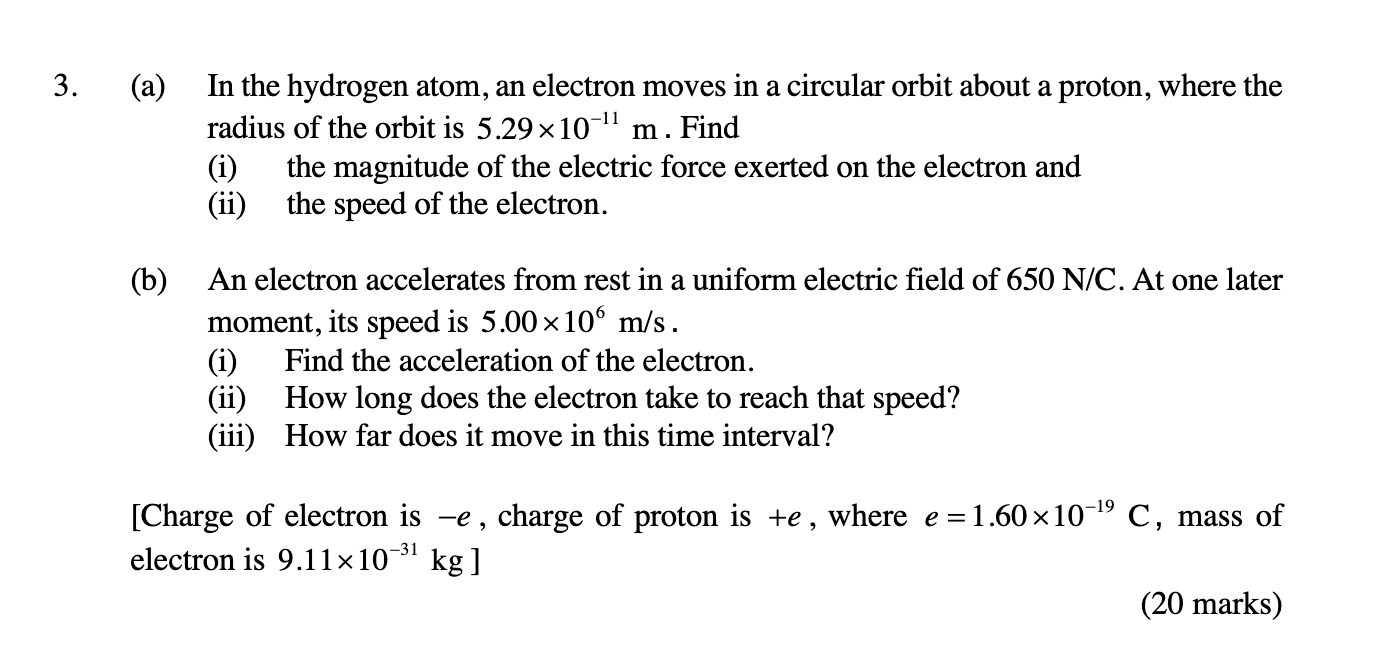(a) In the hydrogen atom, an electron moves in a circular orbit about a proton, where the redius of the orbit is $5.29 \times 10^{-11}$ m. Find (i) the magnitude of the electric fo... (a) In the hydrogen atom, an electron moves in a circular orbit about a proton, where the redius of the orbit is $5.29 \times 10^{-11}$ m. Find (i) the magnitude of the electric force exerted on the electron and (ii) the speed of the electron. (b) An electron accelerates from rest in a uniform electric field of 650 N/C. At one later moment, its speed is $5.00 \times 10^6$ m/s. (i) Find the acceleration of the electron. (ii) How long does the electron take to reach that speed? (iii) How far does it move in this time interval?

Understand the Problem
This question is a physics problem dealing with electrons and electric fields. Part (a) focuses on an electron orbiting a proton in a hydrogen atom, and requires us to find the electric force and the speed of the electron. Part (b) looks at the acceleration of an electron in a uniform electric field, and requires us to find the acceleration, the time taken to reach a certain speed, and the distance traveled during this time.
Answer
(a) (i) $F = 8.23 \times 10^{-8} \, \text{N}$ (ii) $v = 2.19 \times 10^6 \, \text{m/s}$ (b) (i) $a = 1.14 \times 10^{14} \, \text{m/s}^2$ (ii) $t = 4.39 \times 10^{-8} \, \text{s}$ (iii) $x = 0.011 \, \text{m}$
Answer for screen readers
(a) (i) $F = 8.23 \times 10^{-8} , \text{N}$ (ii) $v = 2.19 \times 10^6 , \text{m/s}$ (b) (i) $a = 1.14 \times 10^{14} , \text{m/s}^2$ (ii) $t = 4.39 \times 10^{-8} , \text{s}$ (iii) $x = 0.011 , \text{m}$
Steps to Solve
- (a)(i) Calculate the electric force
The magnitude of the electric force between the electron and proton is given by Coulomb's law:
$F = k \frac{|q_1 q_2|}{r^2}$,
where $k = 8.987 \times 10^9 , \text{N m}^2/\text{C}^2$, $q_1 = q_p = +1.60 \times 10^{-19} , \text{C}$, $q_2 = q_e = -1.60 \times 10^{-19} , \text{C}$, and $r = 5.29 \times 10^{-11} , \text{m}$.
Plug in the values and solve for $F$:
$F = (8.987 \times 10^9) \frac{(1.60 \times 10^{-19})^2}{(5.29 \times 10^{-11})^2}$
- (a)(ii) Calculate the electron speed
The electric force provides the centripetal force required for the circular motion of the electron:
$F = \frac{mv^2}{r}$,
where $m = 9.11 \times 10^{-31} , \text{kg}$ and $r = 5.29 \times 10^{-11} , \text{m}$. Solve for $v$:
$v = \sqrt{\frac{Fr}{m}}$
Plug the force $F$ calculated in the previous step, along with the given values for $r$ and $m$.
- (b)(i) Calculate the acceleration
The electric force on the electron is given by $F = qE$, where $E = 650 , \text{N/C}$ is the electric field. Using Newton's second law, $F = ma$, we can find the acceleration:
$a = \frac{qE}{m}$,
where $q=1.60 \times 10^{-19} , \text{C}$ and $m = 9.11 \times 10^{-31} , \text{kg}$.
- (b)(ii) Calculate the time to reach the specified speed
Use the kinematic equation $v = v_0 + at$, where $v_0 = 0 , \text{m/s}$ (since the electron starts from rest), $v = 5.00 \times 10^6 , \text{m/s}$ and $a$ is calculated in the previous step. Solve for $t$:
$t = \frac{v}{a}$
- (b)(iii) Calculate the distance traveled
Use the kinematic equation $x = v_0t + \frac{1}{2}at^2$. Since $v_0 = 0$, this simplifies to:
$x = \frac{1}{2}at^2$.
Plug in the values for $a$ and $t$ to find the distance $x$.
(a) (i) $F = 8.23 \times 10^{-8} , \text{N}$ (ii) $v = 2.19 \times 10^6 , \text{m/s}$ (b) (i) $a = 1.14 \times 10^{14} , \text{m/s}^2$ (ii) $t = 4.39 \times 10^{-8} , \text{s}$ (iii) $x = 0.011 , \text{m}$
More Information
The electric force in the hydrogen atom is responsible for keeping the electron bound to the proton. The incredible acceleration experienced by the electron in the electric field showcases the power of electric forces on small charged particles.
Tips
- Forgetting to square the radius in Coulomb's law.
- Using the wrong mass (e.g., mass of proton instead of electron).
- Incorrect unit conversions.
- Using incorrect kinematic equations or incorrectly applying them.
- Not using absolute value for charges in Coulomb's Law when calculating magnitude.
AI-generated content may contain errors. Please verify critical information